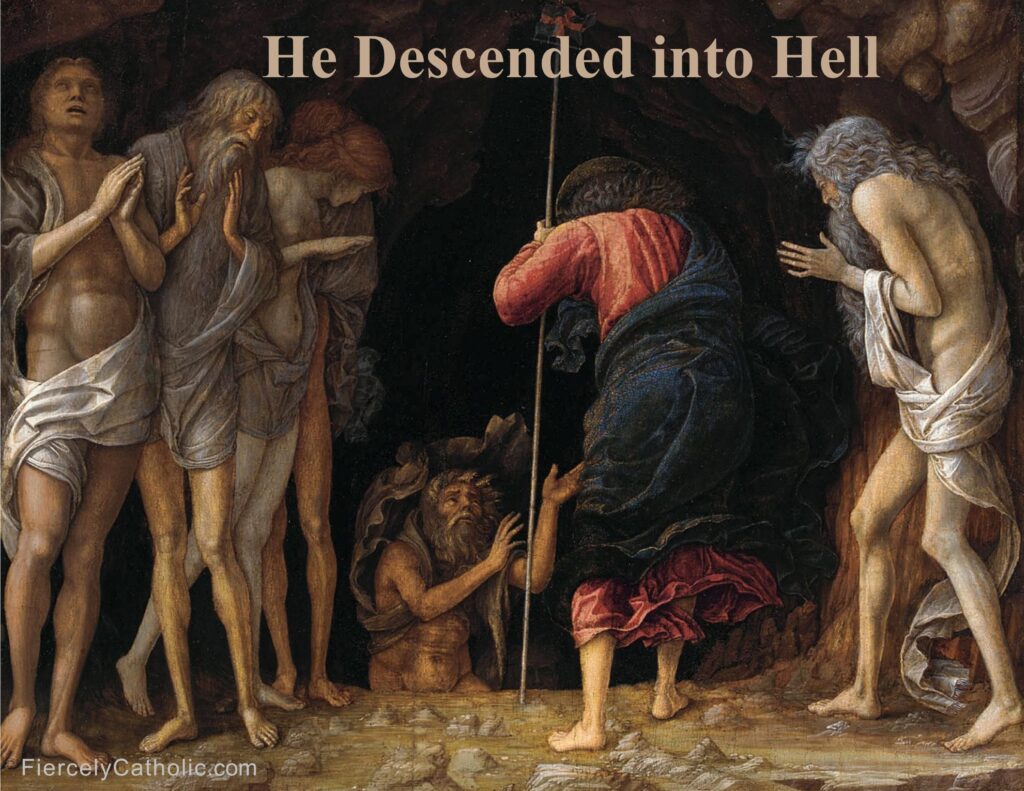
The Apostle’s Creed states that Jesus descended into Hell after He was crucified, died, and was buried.
Like all men, Jesus did experience death. His divine soul joined the other souls in the home of the dead while his body remained in the tomb.
Jesus descended not to be punished but to free the souls of the just who were waiting for Him to open the door into Heaven at the time of the Resurrection. This is referred to as the Harrowing of Hell.
This place where Jesus descended is referred to as the Netherworld or Limbo. It is called Hades in Greek or Sheol in Hebrew. It is not the same place as the Hell of eternal damnation.
Each year on Holy Saturday, reflecting on Jesus’ descent into Hell has a prominent place in the Office of Readings which include an ancient homily from an unknown author.
To Hell and back because of love:
For Christ also suffered for sins once, the righteous for the sake of the unrighteous, that He might lead you to God. Put to death in the flesh, He was brought to life in the spirit. In it He also went to preach to the spirits in prison, who had once been disobedient while God patiently waited in the days of Noah during the building of the ark, in which a few persons, eight in all, were saved through water.
1 Peter 3: 18-20
Before Jesus’ Resurrection, all souls went to one place:
The righteous waited for Him:
In the first letter of St. Peter we read again: “. . . the Good News was also announced to the dead, so that despite having suffered, losing the life of the body, the condemnation common to all men, they may live according to God in spirit “. Even this verse, although not easy to interpret, reaffirms the concept of the “descent into Hell” as the last phase of the Messiah’s mission: a phase “condensed” in a few days by the texts that try to make a presentation accessible to those who are accustomed to reason and speak in temporal and spatial metaphors, but immensely vast in its real meaning of extending the redemptive work to all men of all times and places, even those who in the days of Christ’s death and burial they were already lying in the “kingdom of the dead”.
Pope John Paul II, General Audience, January 11, 1989
Sheol, Hades, and Hell:
Leading people out of the land of the dead:
Scripture calls the abode of the dead, to which the dead Christ went down, “Hell” – Sheol in Hebrew or Hades in Greek – because those who are there are deprived of the vision of God. Such is the case for all the dead, whether evil or righteous, while they await the Redeemer: which does not mean that their lot is identical, as Jesus shows through the parable of the poor man Lazarus who was received into “Abraham’s bosom”: “It is precisely these holy souls, who awaited their Savior in Abraham’s bosom, whom Christ the Lord delivered when He descended into Hell.” Jesus did not descend into Hell to deliver the damned, nor to destroy the Hell of damnation, but to free the just who had gone before Him.
Catechism of the Catholic Church 633
Something strange is happening here:
An invitation from Jesus:
The Truth, Goodness, and Beauty of the Catholic Church
300 years of Catholic sisters:
Share this page with friends and family to start a conversation about your faith.
Don’t miss a post. Learn more about the Catholic Church and strengthen your Catholic faith.
Find more Fiercely Catholic video issues here.
Subscribe here.


